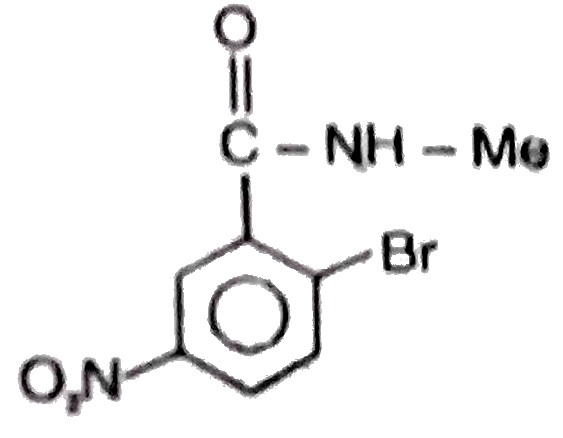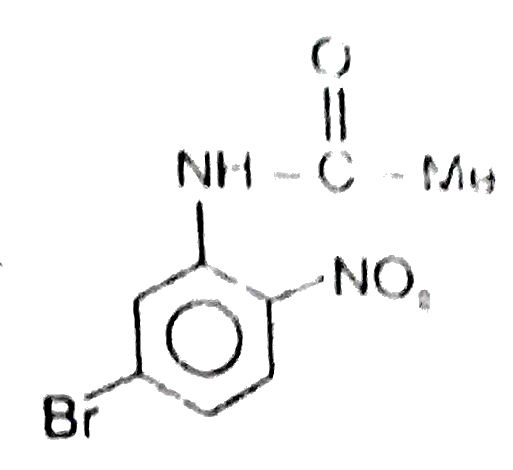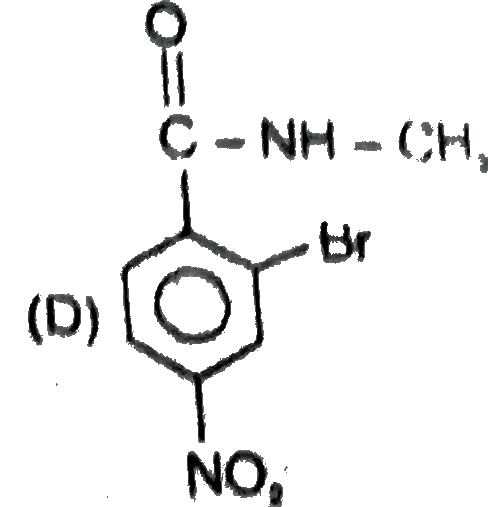Aldehydes and Ketones react with NH2OH to form aldoximes and Ketoximes respectively. Configuration of these compounds can be determined by Beckmann rearrangement as that group migrates which is anti w.r.t. -OH.

It is interesting to note that the migration of group is completely retentive and no loss of optical activity is seen.
Q.  Product
Product
Which of the following statements is true about the product?
It is also (+) dextrorotatory
Both (+) (-) forms are obtained in equal amount
It has 'S' configuration or the chiral carbon
none of these
The correct Answer is:B
Shift is retentive therefore initoal configuration will be maintained. Initially it is "S" and afterwards will be R due to change in.

Topper's Solved these Questions
- GENERAL ORGANIC CHEMISTRYBOOK - FIITJEECHAPTER - GENERAL ORGANIC CHEMISTRYEXERCISE - REASONING TYPE QUESTIONS
9 Videos
- GENERAL ORGANIC CHEMISTRYBOOK - FIITJEECHAPTER - GENERAL ORGANIC CHEMISTRYEXERCISE - MATCH THE FOLLOWING QUESTION
16 Videos
- GENERAL ORGANIC CHEMISTRYBOOK - FIITJEECHAPTER - GENERAL ORGANIC CHEMISTRYEXERCISE - MORE THAN ONE CORRECT CHOICES
24 Videos
- GASEOUS STATEBOOK - FIITJEECHAPTER - GASEOUS STATEEXERCISE - MATCHING LIST TYPE QUESTION
1 Videos
- HYDROCARBONSBOOK - FIITJEECHAPTER - HYDROCARBONSEXERCISE - SINGLE INTEGER ANSWER TYPE QUESTION
9 Videos
Similar Questions
Aldehydes and Ketones react with NH2OH to form aldoximes and Ketoximes respectively. Configuration of these can be determined by Beckmann rearragement as that group migrates which is anti w.r.t -OH

Which step is Rate determening step ?
View SolutionAlldehydes and Ketones react with NH2OH to form aldoximes and Ketoximes respectively. Configuration of these can be determined by Beckmann rearragement as that group migrates which is anti w.r.t -OH

[X]H2SO4−−−→H2O−−→Ph−NH2+CH3−C∣∣O−OH
Identify the configuration of [X] compound
View Solution
Knowledge Check
Aldehydes and Ketones reacts with NH2OH to form Aldoximes and Ketoximes respectively.Configuration of these can be determined by Beckmann rearrangement as that group migrates which is anti w.r.t-OH

It is interesting to note that the migration of group is completely retentive and no loss of optical activity is seen.
 Following is true about product AIt is also (+) laevorotatoryBBoth (+) and (-) forms are obtained in equal amountCIt is having 'S' configuration for chiral carbonDit is having R configuration for chiral carbon
Following is true about product AIt is also (+) laevorotatoryBBoth (+) and (-) forms are obtained in equal amountCIt is having 'S' configuration for chiral carbonDit is having R configuration for chiral carbonAldehydes and Ketones reacts with NH2OH to form Aldoximes and Ketoximes respectively.Configuration of these can be determined by Beckmann rearrangement as that group migrates which is anti w.r.t-OH

It is interesting to note that the migration of group is completely retentive and no loss of optical activity is seen.
 A
A B
B C
C D
D
Alldehydes and Ketones react with NH2OH to form aldoximes and Ketoximes respectively. Configuration of these can be determined by Beckmann rearragement as that group migrates which is anti w.r.t -OH

Which step is Rate determening step ?AIBIICIIIDIV
Alldehydes and Ketones react with NH2OH to form aldoximes and Ketoximes respectively. Configuration of these can be determined by Beckmann rearragement as that group migrates which is anti w.r.t -OH


The product (B) is :
View SolutionCarbon-oxygent bond in ethers can be cleaved b halogen acids, sulphuric acid, phosphorus pentachlodie, etc. The cleavage of C-O bond take place under drastic conditions with excess of hydrogen halides.
R−O−R+2HX→2RX+H2O
If hydrogen halide is not taken in excess then a molecule of alcohol and alkyl halide are formed.
R−O−R+HI373K−−→R−OH+R−I
The order of reactivity of hydrogen halides towards the given reaction depends on the bond strength of halogenated acids, weaker is the H-X bond, greter is its reactivity. In case of unsymmetrical ethers, the site of cleavage is such that the halide is formed from the alkyl group which is smaller in size. However, when one of the alkyl group is tertiary, the halide formed is the tertiary halide.
Indiate wheterh the following statements / reactions are true or false.
Tertiar butyl methyl ether reacts with HI according to the following reaction.
CH3−CH3∣C∣CH3−OCH3+HI→CH3−CH3∣C∣CH3−OH+CH3I
(a) True (b) False
View SolutionAldehydes and Ketones reacts with NH2OH to form Aldoximes and Ketoximes respectively.Configuration of these can be determined by Beckmann rearrangement as that group migrates which is anti w.r.t-OH

It is interesting to note that the migration of group is completely retentive and no loss of optical activity is seen.
CH3CHO+NH2OHΔ−−→PH⊕−−→QBr2/KOH−−−−−−→R(CH3NH2) (as only product) Following is correct
View SolutionAlldehydes and Ketones react with NH2OH to form aldoximes and Ketoximes respectively. Configuration of these can be determined by Beckmann rearragement as that group migrates which is anti w.r.t -OH

[X]H2SO4−−−→H2O−−→Ph−NH2+CH3−C∣∣O−OH
Identify the configuration of [X] compound
View SolutionAmines are less reactive in substitution reactions. Their reactivity is much lesser than alcohols and alkylflourides towards substitution. Protonation of the amino group makes it a better leaving group, but not nearly as good a leaving group as a protonated alcohol. Protonated amino groups cannot be displaced by OH− because it would react immediately with the acidic hydrogen which would convert it in to a poor nucleophile. The leaving group in quarternary ammonium ion has about the same leaving tendency as a protonated amino group but does not have acidic hydrogen. the reaction of a quarternary ammonium ion with hydroxide ion is known as Hoffmann elimination reaction. The leaving group is tertiary amine. Since a tertiary amine is only a moderately good leaving group, the reaction requires heat. The carbon to hwich the tertiary amine is attached is designated as α carbon. When the hydroxide ion starts to remove a β H form from a quarternary ammonium ion, the leaving group does not immediately start to leave because a tertiary amine is not a good leaving group. As a result, a partial negative charge bulds up on the carbon from which the proton is removed.
Which of the following statements are true regarding Hoffmann elimination?
View Solution
